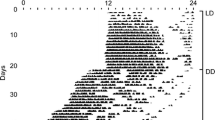Abstract
Syrian hamsters with intergeniculate leaflet or sham lesions were given tests with a series of light pulses of gradually decreasing intensities. The light pulses were given early in the night, at zeitgeber time 14–15. The amount of wheel running during the pulses was compared to that in the same hour on a night with no light pulses. Hamsters with intergeniculate leaflet lesions showed a significantly greater suppression of their wheel running in response to light than the sham-lesioned animals. The lesioned animals also had larger negative phase angles of entrainment to the 14:10-h light-dark cycle than sham-operated controls. However, phase shifting in response to light pulses at either zeitgeber time 14 or 18 was not significantly altered by the lesions. Preferences for spending more time in a dark than a light area were not abolished by the lesions. It is concluded that the intergeniculate leaflet in the Syrian hamster cannot be of paramount importance for masking of locomotor activity by light but may play a modulating role.
Similar content being viewed by others
Author information
Authors and Affiliations
Additional information
Accepted: 30 January 1999
Rights and permissions
About this article
Cite this article
Redlin, U., Vrang, N. & Mrosovsky, N. Enhanced masking response to light in hamsters with IGL lesions. J Comp Physiol A 184, 449–456 (1999). https://doi.org/10.1007/s003590050344
Issue Date:
DOI: https://doi.org/10.1007/s003590050344



